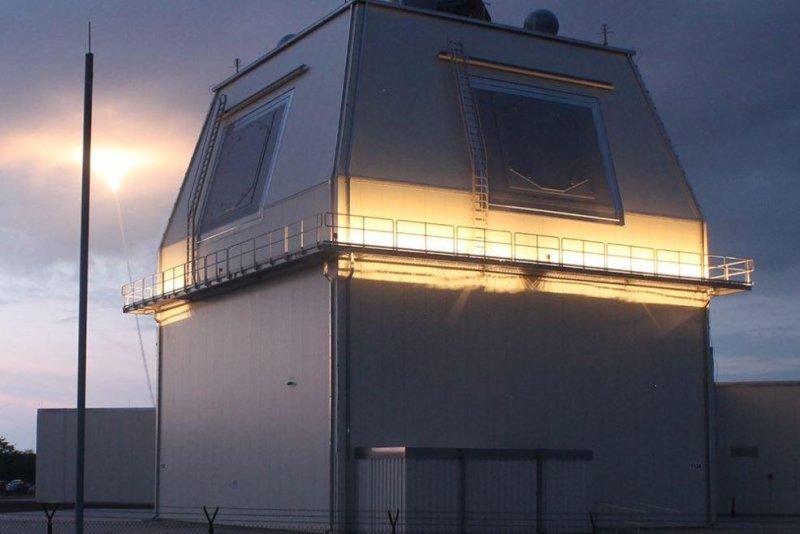1 of 2 | Japan has received approval from the U.S. State Department to purchase two land-based Aegis Ballistic Missile Defense systems at a cost of $2.150 billion. Photo courtesy
Lockheed Martin
Jan. 30 (UPI) -- The U.S. State Department has approved Japan's $2.15 billion purchase of two land-based Aegis Ballistic Missile Defense systems.
On Tuesday, the Defense Security Cooperation Agency delivered the required certification notifying Congress of the possible sale.
Defense News reported it was the first foreign military sales announcement since the end of a 35-day partial government shutdown. The Defense Department was not closed during the shutdown, but the State Department, which was shuttered, needed to approve the deal.
Lockheed Martin Rotary and Mission Systems is the primary contractor for the Aegis Weapon System and Multi-Mission Signal Processors. General Dynamics will provide the Command and Control Processor Refresh. Also included are radio navigation equipment, ordnance, IFF systems, and construction services for six vertical launch system launcher module enclosures.
"This proposed sale will provide the government of Japan with an enhanced capability against increasingly sophisticated ballistic missile threats and create an expanded, layered defense of its homeland," the State Department said in a news release. "Japan, which already has the AEGIS in its inventory, will have no difficulty absorbing this system into its armed forces."
The State Department noted the United States must assist Japan in developing and maintaining a strong and effective self-defense capability, especially against North Korea.
In addition, the arms "will contribute to the foreign policy and national security of the United States by improving the security of a major ally that is a force for political stability and economic progress in the Asia-Pacific region."
To fund the systems, Japan's defense budget will grow to $47 billion in fiscal 2019, starting in April, the government announced last month. Japan already has the seventh-largest defense budget in the world, and it's about 1 percent of the gross domestic product. Conversely, China and the United States spend between 2 and 3 percent of their gross domestic products annually on defense.
On Jan. 20, Japan's Defense Minister Takeshi Iwaya visited a U.S. Defense Department facility on Kauai island, Hawaii, the test site for the Aegis Ashore land-based missile interception system. He was given information on the missile system's functionality.
"I am convinced that introducing Aegis Ashore will strengthen our defense capabilities against a missile attack," Iwaya said to the media after visiting the facility. "We will steadily proceed with introduction of the system."
The government plans to deploy the systems in Akita and Yamaguchi prefectures.
Akita Prefecture is in northwestern Honshu on the Sea of Japan coast with about 308,000 people.
"Why the Defense Ministry chose Araya as a site for Aegis Ashore is a mystery," Kozo Kazama, who leads a local group opposed to the Aegis plan, told Japan Times. "Unlike the other candidate site in Yamaguchi, which is located away from a major urban center, Araya is in a major city.
"There are so many concerns about the effects of the radar on both electronic devices in the area and on stress levels, as well as all sorts of security concerns related to the presence of missiles so close to so many people," Kazama said.
In August, Defense Ministry officials told Akita residents about 200 personnel, as well as radar facilities and missile launchers, would be stationed at the Aegis Ashore site.
At the other site, the town of Abu lies deep in the Yamaguchi Prefecture countryside, about a 30-minute drive from the port city of Hagi.
"There are concerns about radio waves from the Aegis radar and whether cellphone reception and television sets would be affected," said Sumiko Hara, 75, one of the leaders of the local opposition.
And you can't say that there's been a sufficient investigation into the effects of the Aegis Ashore on human health."
Also, part of the area is classified as an active volcano zone, including a lava plateau.
"Unfortunately, as this is a Defense Ministry project, the local governments are limited in what they can do and the central government can keep much information secret," said Rota Asai, a member of the Hagi Municipal Assembly.
On Tuesday, James H. Anderson, the assistant secretary of defense for strategy, plans and capabilities, outlined the U.S. missile defense strategy during a speech at the Brookings Institution in Washington, D.C.
Anderson said the strategy covers lethality, partnership and reform.
He noted in the presentation that China and Russia are developing advanced cruise missiles and hypersonic weapons that can potentially overcome U.S. defenses.
To address regional threats and protect partner nations, the United States has looked to deploy additional missile defense assets, including both Patriot and Aegis systems as "partner nations are building up their air and missile defenses, with the possibility of integrating them with U.S. systems" -- including those deployed or under construction in Romania, Poland, Denmark and the Netherlands.
"Diplomacy and deterrence are the primary strategies to protect the nation, deployed forces and U.S. allies from missile attacks," according to a Defense Department summary of the presentation. "Should that fail, the U.S. is developing a layered missile defense system as well as offensive capability."














